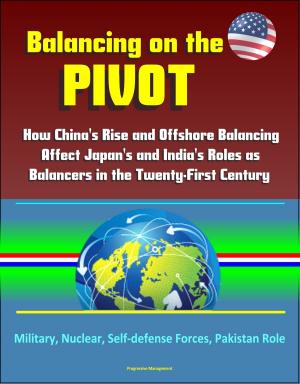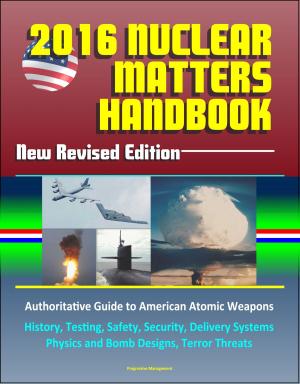Modern Day Sino-Soviet Split: Russia's Role in the U.S. Pivot Towards Asia - Combining History and a Realist Interpretation of International Relations for Consideration of Russian Role
Nonfiction, History, Asian, China, Russia| Author: | Progressive Management | ISBN: | 9781370570317 |
| Publisher: | Progressive Management | Publication: | March 19, 2017 |
| Imprint: | Smashwords Edition | Language: | English |
| Author: | Progressive Management |
| ISBN: | 9781370570317 |
| Publisher: | Progressive Management |
| Publication: | March 19, 2017 |
| Imprint: | Smashwords Edition |
| Language: | English |
This report has been professionally converted for accurate flowing-text e-book format reproduction. As the United States pivots toward Asia, U.S. national security professionals must include Russia and Sino-Russian relations as a vital part of any strategy to manage China. In January 2012, the United States announced a strategic shift towards the Asia-Pacific because U.S. economic and security interests are increasingly linked to developments in Asia. In the twenty years since the collapse of Soviet Communism, U.S. strategy in Asia increasingly focused on the rise of the People's Republic of China (PRC). However, the US failed to include another major country in Asia, Russia. America placed Russia and China into two separate strategies for Europe and Asia respectively. The US intended to separate China and Russia but instead, Beijing and Moscow have substantially improved relations over the past twenty years and entered a new strategic partnership. Analysts now predict that China and Russia will form a future strategic alliance and the United States will fight a future war against a Chinese-Russian bloc. Sino-Russian relations, past and present, are an important feature of major power relations in Asia. China and Russia have maintained tense relations throughout their history, but seized opportunities to form strategic partnerships when their interests aligned. During the Cold War, Moscow and Beijing formed a Sino-Soviet alliance that significantly complicated U.S. strategy in Asia. The United States learned to manage the US-China-Russia triangular relationship as part of U.S. Cold War strategy. After the Sino-Soviet split, the US made a major foreign policy reversal improving relations with China as a strategic counterweight against the Soviet Union. While China and Russia develop their new "strategic partnership," American foreign policymakers ought to rediscover the importance of Sino-Russian relations.
Conclusion: The United States successfully managed US-China-Russia relations during the Cold War. However, since the end of the Cold War, the US has ignored Russia's role as an Asian power leaving Moscow out of U.S. strategy for the Asia-Pacific. Instead, the US pursued two separate and disconnected strategies; one isolated Russia in Europe while the other contained China in Asia. All the while, China and Russia drifted away from America and toward each other as they developed a new strategic partnership. Today, Beijing and Moscow yield significant global influence through the current strategic partnership. In the future, China and Russia could transform their partnership into an alliance, threatening U.S. interests in the region. The US intends to counter the rise of China by making a strategic pivot towards the Asia-Pacific. Going forward, American policymakers and strategists must recognize that Sino-Russian relations, past and present, are an essential aspect of dealing with China.
This report has been professionally converted for accurate flowing-text e-book format reproduction. As the United States pivots toward Asia, U.S. national security professionals must include Russia and Sino-Russian relations as a vital part of any strategy to manage China. In January 2012, the United States announced a strategic shift towards the Asia-Pacific because U.S. economic and security interests are increasingly linked to developments in Asia. In the twenty years since the collapse of Soviet Communism, U.S. strategy in Asia increasingly focused on the rise of the People's Republic of China (PRC). However, the US failed to include another major country in Asia, Russia. America placed Russia and China into two separate strategies for Europe and Asia respectively. The US intended to separate China and Russia but instead, Beijing and Moscow have substantially improved relations over the past twenty years and entered a new strategic partnership. Analysts now predict that China and Russia will form a future strategic alliance and the United States will fight a future war against a Chinese-Russian bloc. Sino-Russian relations, past and present, are an important feature of major power relations in Asia. China and Russia have maintained tense relations throughout their history, but seized opportunities to form strategic partnerships when their interests aligned. During the Cold War, Moscow and Beijing formed a Sino-Soviet alliance that significantly complicated U.S. strategy in Asia. The United States learned to manage the US-China-Russia triangular relationship as part of U.S. Cold War strategy. After the Sino-Soviet split, the US made a major foreign policy reversal improving relations with China as a strategic counterweight against the Soviet Union. While China and Russia develop their new "strategic partnership," American foreign policymakers ought to rediscover the importance of Sino-Russian relations.
Conclusion: The United States successfully managed US-China-Russia relations during the Cold War. However, since the end of the Cold War, the US has ignored Russia's role as an Asian power leaving Moscow out of U.S. strategy for the Asia-Pacific. Instead, the US pursued two separate and disconnected strategies; one isolated Russia in Europe while the other contained China in Asia. All the while, China and Russia drifted away from America and toward each other as they developed a new strategic partnership. Today, Beijing and Moscow yield significant global influence through the current strategic partnership. In the future, China and Russia could transform their partnership into an alliance, threatening U.S. interests in the region. The US intends to counter the rise of China by making a strategic pivot towards the Asia-Pacific. Going forward, American policymakers and strategists must recognize that Sino-Russian relations, past and present, are an essential aspect of dealing with China.















